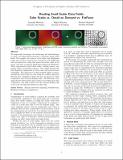Reading small scalar data fields: color scales vs. Detail on Demand vs. FatFonts
Abstract
We empirically investigate the advantages and disadvantages of color- and digit-based methods to represent small scalar fields. We compare two types of color scales (one brightness-based and one that varies in hue, saturation and brightness) with an interactive tooltip that shows the scalar value on demand, and with a symbolic glyph-based approach (FatFonts). Three experiments tested three tasks: reading values, comparing values, and finding extrema. The results provide the first empirical comparisons of color scales with symbol-based techniques. The interactive tooltip enabled higher accuracy and shorter times than the color scales for reading values but showed slow completion times and low accuracy for value comparison and extrema finding tasks. The FatFonts technique showed better speed and accuracy for reading and value comparison, and high accuracy for the extrema finding task at the cost of being the slowest for this task.
Citation
Manteau , C , Nacenta , M & Mauderer , M 2017 , Reading small scalar data fields: color scales vs. Detail on Demand vs. FatFonts . in Proceedings of the 43rd Graphics Interface Conference (GI '17) . Canadian Human-Computer Communications Society , pp. 50-56 , Graphics Interface 2017 , Edmonton, Alberta , Canada , 16/05/17 . https://doi.org/10.20380/GI2017.07 conference
Publication
Proceedings of the 43rd Graphics Interface Conference (GI '17)
Type
Conference item
Rights
© 2017, the Author(s). This work has been made available online in accordance with the publisher’s policies. This is the author created, accepted version manuscript following peer review and may differ slightly from the final published version. The final published version of this work is available at http://graphicsinterface.org/proceedings/gi2017/
Items in the St Andrews Research Repository are protected by copyright, with all rights reserved, unless otherwise indicated.

